Taxation Law Assignment: Australian Taxation Law and Case Studies
VerifiedAdded on 2022/10/12
|17
|3562
|242
Homework Assignment
AI Summary
This Taxation Law assignment provides detailed answers to several questions related to Australian income tax law. The assignment explores topics such as the definition of a small business entity, deductibility of gifts, marginal tax rates, capital gains tax, CGT events, and the tax-free threshold. It also delves into the differences between ordinary and statutory income, Medicare Levy and Medicare Levy Surcharge. The assignment further analyzes the concept of 'usual place of abode' and 'permanent place of abode' in the context of residency. Moreover, it examines the deductibility of various expenses, including HECS-HELP, travel costs, books, childcare, home repairs, clothing, and legal fees. The student provides a thorough analysis of each expense based on relevant tax laws and case precedents, offering a comprehensive understanding of the subject matter.
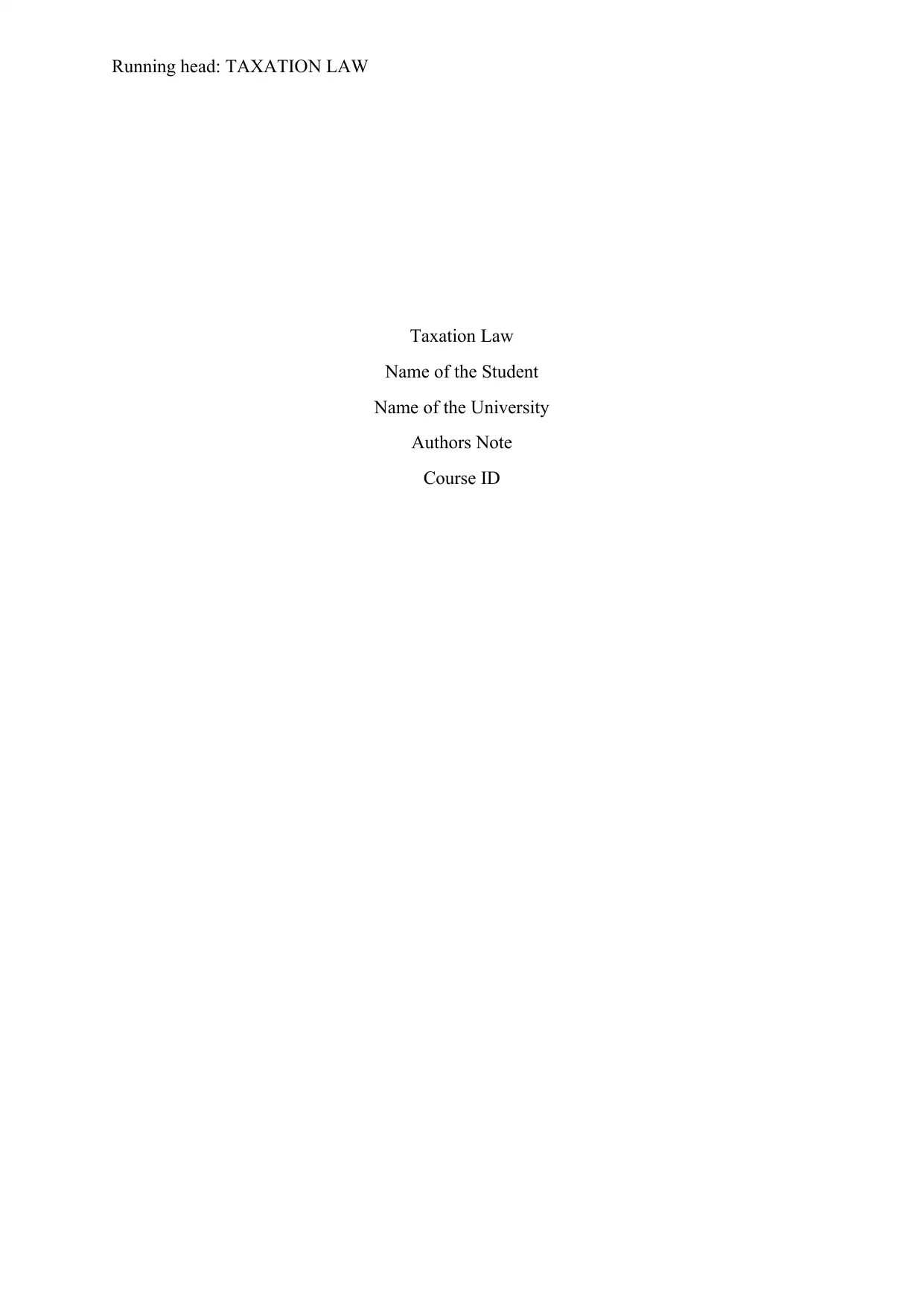
Running head: TAXATION LAW
Taxation Law
Name of the Student
Name of the University
Authors Note
Course ID
Taxation Law
Name of the Student
Name of the University
Authors Note
Course ID
Paraphrase This Document
Need a fresh take? Get an instant paraphrase of this document with our AI Paraphraser
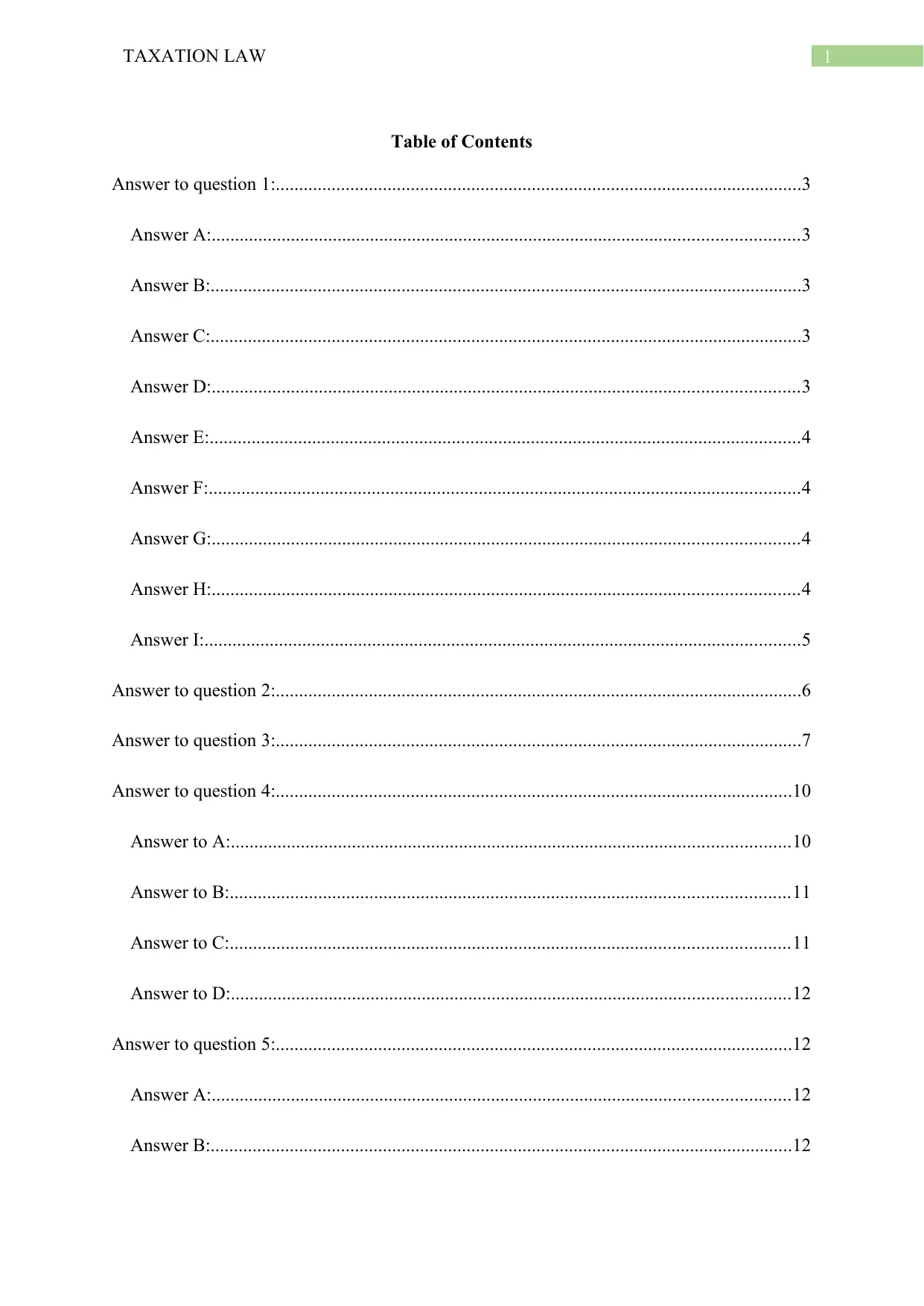
1TAXATION LAW
Table of Contents
Answer to question 1:.................................................................................................................3
Answer A:..............................................................................................................................3
Answer B:...............................................................................................................................3
Answer C:...............................................................................................................................3
Answer D:..............................................................................................................................3
Answer E:...............................................................................................................................4
Answer F:...............................................................................................................................4
Answer G:..............................................................................................................................4
Answer H:..............................................................................................................................4
Answer I:................................................................................................................................5
Answer to question 2:.................................................................................................................6
Answer to question 3:.................................................................................................................7
Answer to question 4:...............................................................................................................10
Answer to A:........................................................................................................................10
Answer to B:........................................................................................................................11
Answer to C:........................................................................................................................11
Answer to D:........................................................................................................................12
Answer to question 5:...............................................................................................................12
Answer A:............................................................................................................................12
Answer B:.............................................................................................................................12
Table of Contents
Answer to question 1:.................................................................................................................3
Answer A:..............................................................................................................................3
Answer B:...............................................................................................................................3
Answer C:...............................................................................................................................3
Answer D:..............................................................................................................................3
Answer E:...............................................................................................................................4
Answer F:...............................................................................................................................4
Answer G:..............................................................................................................................4
Answer H:..............................................................................................................................4
Answer I:................................................................................................................................5
Answer to question 2:.................................................................................................................6
Answer to question 3:.................................................................................................................7
Answer to question 4:...............................................................................................................10
Answer to A:........................................................................................................................10
Answer to B:........................................................................................................................11
Answer to C:........................................................................................................................11
Answer to D:........................................................................................................................12
Answer to question 5:...............................................................................................................12
Answer A:............................................................................................................................12
Answer B:.............................................................................................................................12
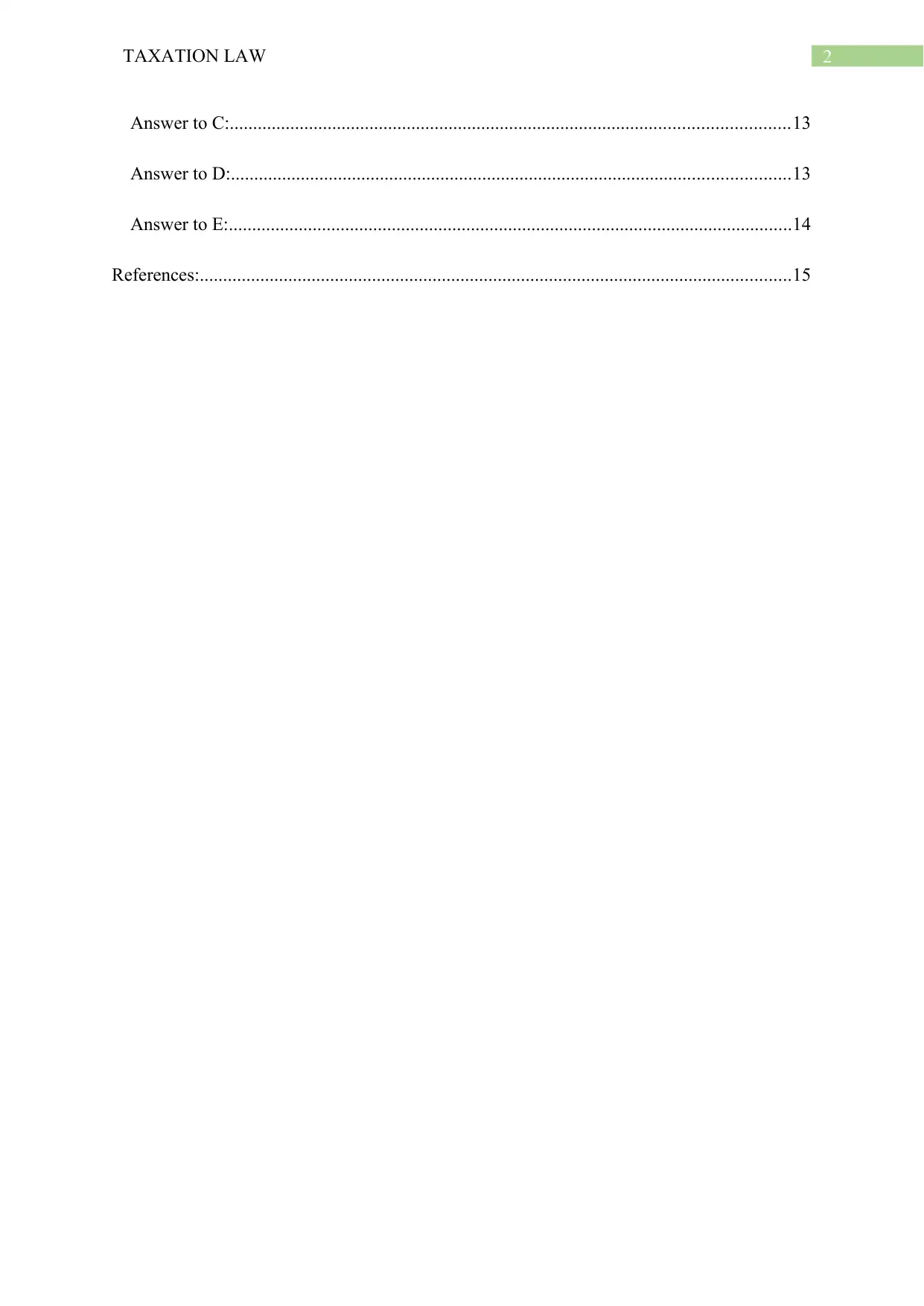
2TAXATION LAW
Answer to C:........................................................................................................................13
Answer to D:........................................................................................................................13
Answer to E:.........................................................................................................................14
References:...............................................................................................................................15
Answer to C:........................................................................................................................13
Answer to D:........................................................................................................................13
Answer to E:.........................................................................................................................14
References:...............................................................................................................................15
⊘ This is a preview!⊘
Do you want full access?
Subscribe today to unlock all pages.

Trusted by 1+ million students worldwide
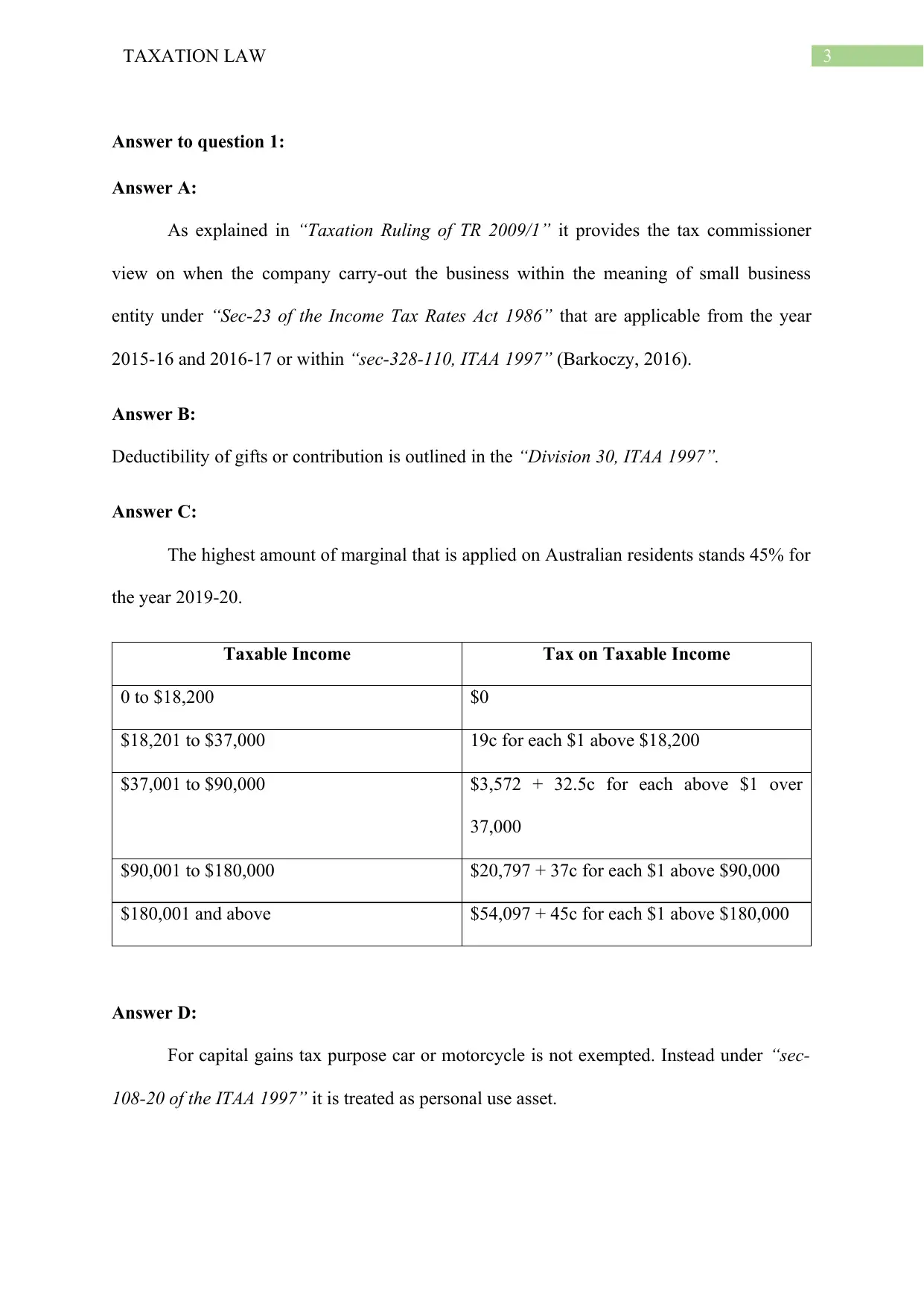
3TAXATION LAW
Answer to question 1:
Answer A:
As explained in “Taxation Ruling of TR 2009/1” it provides the tax commissioner
view on when the company carry-out the business within the meaning of small business
entity under “Sec-23 of the Income Tax Rates Act 1986” that are applicable from the year
2015-16 and 2016-17 or within “sec-328-110, ITAA 1997” (Barkoczy, 2016).
Answer B:
Deductibility of gifts or contribution is outlined in the “Division 30, ITAA 1997”.
Answer C:
The highest amount of marginal that is applied on Australian residents stands 45% for
the year 2019-20.
Taxable Income Tax on Taxable Income
0 to $18,200 $0
$18,201 to $37,000 19c for each $1 above $18,200
$37,001 to $90,000 $3,572 + 32.5c for each above $1 over
37,000
$90,001 to $180,000 $20,797 + 37c for each $1 above $90,000
$180,001 and above $54,097 + 45c for each $1 above $180,000
Answer D:
For capital gains tax purpose car or motorcycle is not exempted. Instead under “sec-
108-20 of the ITAA 1997” it is treated as personal use asset.
Answer to question 1:
Answer A:
As explained in “Taxation Ruling of TR 2009/1” it provides the tax commissioner
view on when the company carry-out the business within the meaning of small business
entity under “Sec-23 of the Income Tax Rates Act 1986” that are applicable from the year
2015-16 and 2016-17 or within “sec-328-110, ITAA 1997” (Barkoczy, 2016).
Answer B:
Deductibility of gifts or contribution is outlined in the “Division 30, ITAA 1997”.
Answer C:
The highest amount of marginal that is applied on Australian residents stands 45% for
the year 2019-20.
Taxable Income Tax on Taxable Income
0 to $18,200 $0
$18,201 to $37,000 19c for each $1 above $18,200
$37,001 to $90,000 $3,572 + 32.5c for each above $1 over
37,000
$90,001 to $180,000 $20,797 + 37c for each $1 above $90,000
$180,001 and above $54,097 + 45c for each $1 above $180,000
Answer D:
For capital gains tax purpose car or motorcycle is not exempted. Instead under “sec-
108-20 of the ITAA 1997” it is treated as personal use asset.
Paraphrase This Document
Need a fresh take? Get an instant paraphrase of this document with our AI Paraphraser
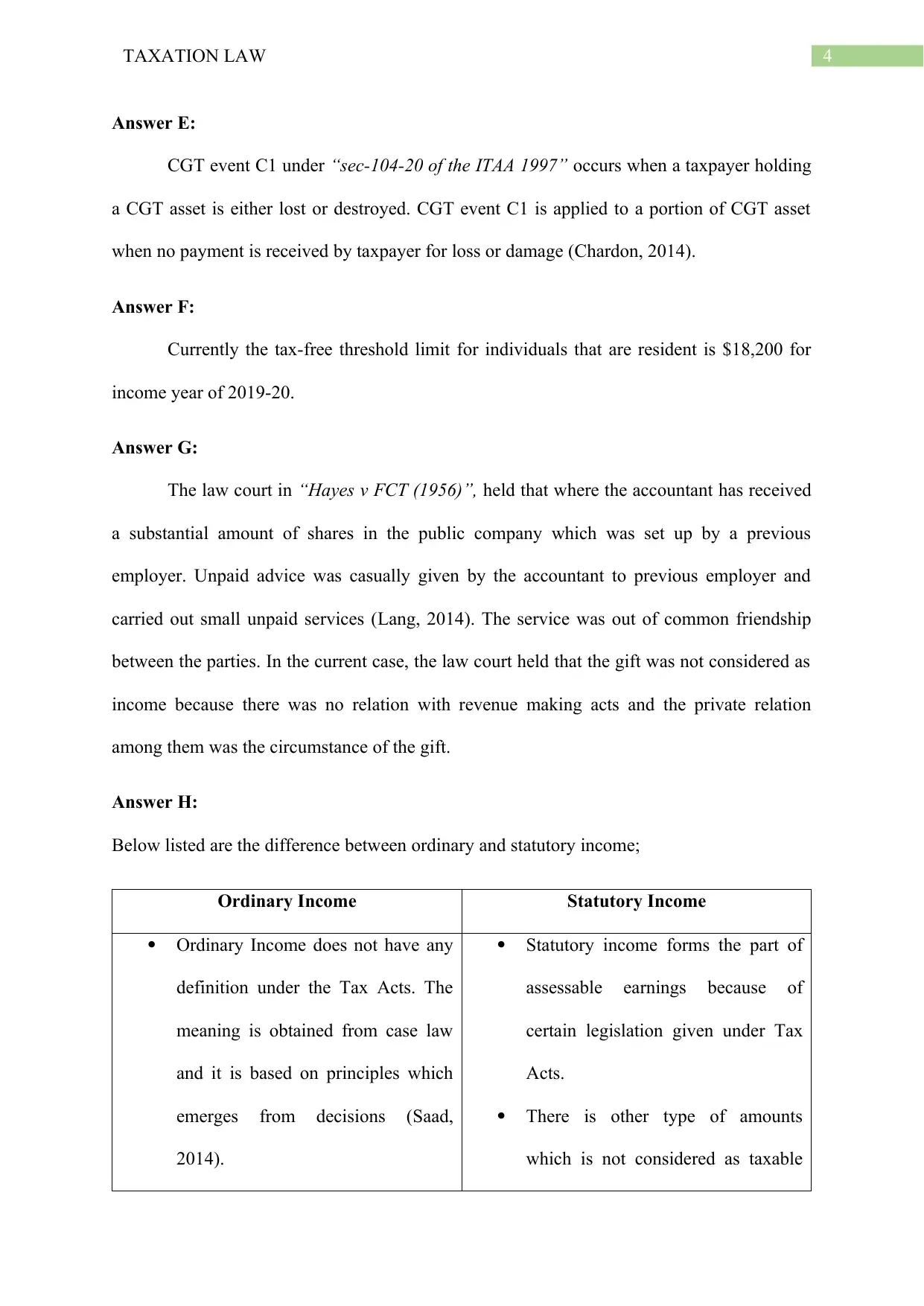
4TAXATION LAW
Answer E:
CGT event C1 under “sec-104-20 of the ITAA 1997” occurs when a taxpayer holding
a CGT asset is either lost or destroyed. CGT event C1 is applied to a portion of CGT asset
when no payment is received by taxpayer for loss or damage (Chardon, 2014).
Answer F:
Currently the tax-free threshold limit for individuals that are resident is $18,200 for
income year of 2019-20.
Answer G:
The law court in “Hayes v FCT (1956)”, held that where the accountant has received
a substantial amount of shares in the public company which was set up by a previous
employer. Unpaid advice was casually given by the accountant to previous employer and
carried out small unpaid services (Lang, 2014). The service was out of common friendship
between the parties. In the current case, the law court held that the gift was not considered as
income because there was no relation with revenue making acts and the private relation
among them was the circumstance of the gift.
Answer H:
Below listed are the difference between ordinary and statutory income;
Ordinary Income Statutory Income
Ordinary Income does not have any
definition under the Tax Acts. The
meaning is obtained from case law
and it is based on principles which
emerges from decisions (Saad,
2014).
Statutory income forms the part of
assessable earnings because of
certain legislation given under Tax
Acts.
There is other type of amounts
which is not considered as taxable
Answer E:
CGT event C1 under “sec-104-20 of the ITAA 1997” occurs when a taxpayer holding
a CGT asset is either lost or destroyed. CGT event C1 is applied to a portion of CGT asset
when no payment is received by taxpayer for loss or damage (Chardon, 2014).
Answer F:
Currently the tax-free threshold limit for individuals that are resident is $18,200 for
income year of 2019-20.
Answer G:
The law court in “Hayes v FCT (1956)”, held that where the accountant has received
a substantial amount of shares in the public company which was set up by a previous
employer. Unpaid advice was casually given by the accountant to previous employer and
carried out small unpaid services (Lang, 2014). The service was out of common friendship
between the parties. In the current case, the law court held that the gift was not considered as
income because there was no relation with revenue making acts and the private relation
among them was the circumstance of the gift.
Answer H:
Below listed are the difference between ordinary and statutory income;
Ordinary Income Statutory Income
Ordinary Income does not have any
definition under the Tax Acts. The
meaning is obtained from case law
and it is based on principles which
emerges from decisions (Saad,
2014).
Statutory income forms the part of
assessable earnings because of
certain legislation given under Tax
Acts.
There is other type of amounts
which is not considered as taxable
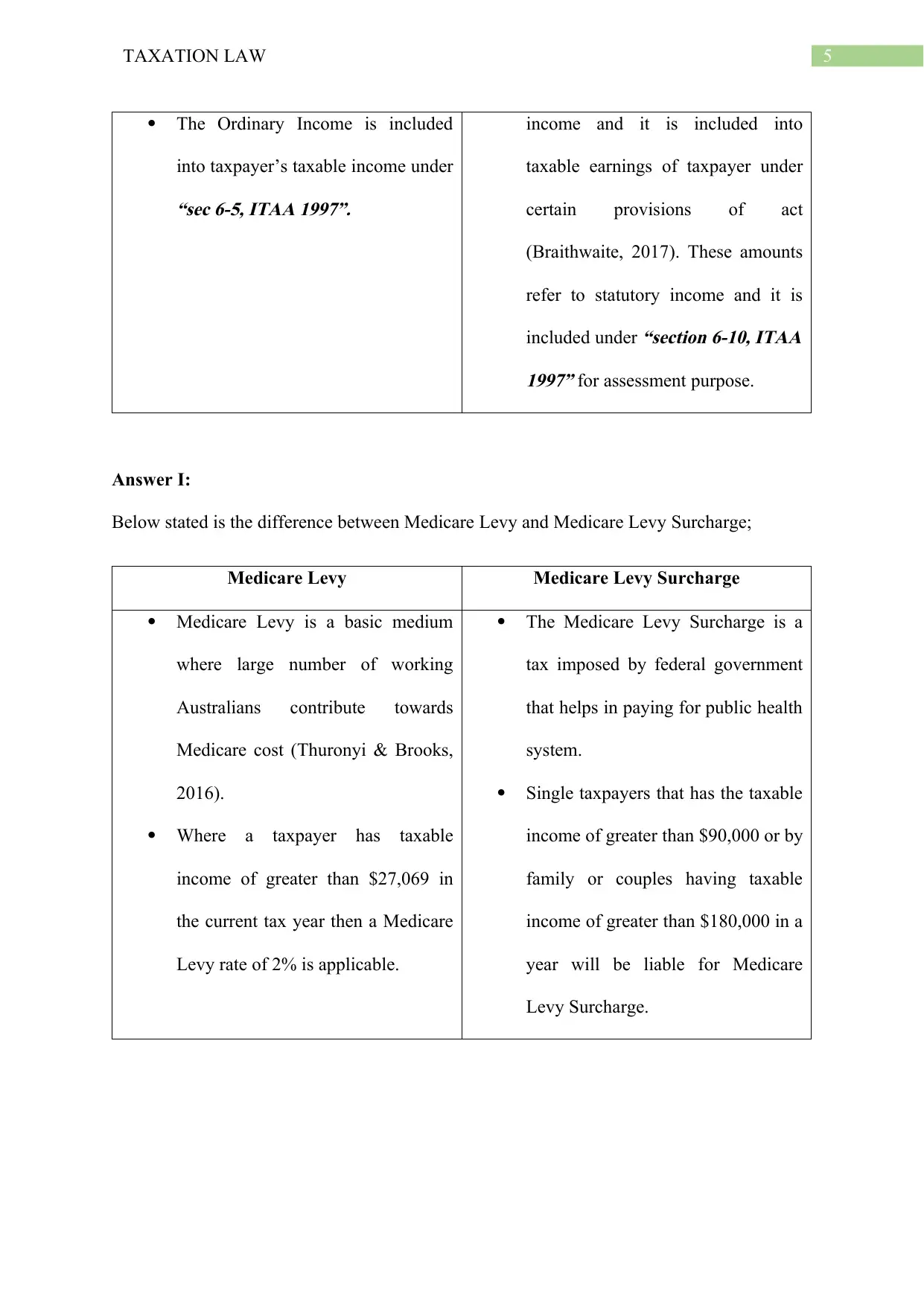
5TAXATION LAW
The Ordinary Income is included
into taxpayer’s taxable income under“sec 6-5, ITAA 1997”.
income and it is included into
taxable earnings of taxpayer under
certain provisions of act
(Braithwaite, 2017). These amounts
refer to statutory income and it is
included under
“section 6-10, ITAA
1997” for assessment purpose.
Answer I:
Below stated is the difference between Medicare Levy and Medicare Levy Surcharge;
Medicare Levy Medicare Levy Surcharge
Medicare Levy is a basic medium
where large number of working
Australians contribute towards
Medicare cost (Thuronyi & Brooks,
2016).
Where a taxpayer has taxable
income of greater than $27,069 in
the current tax year then a Medicare
Levy rate of 2% is applicable.
The Medicare Levy Surcharge is a
tax imposed by federal government
that helps in paying for public health
system.
Single taxpayers that has the taxable
income of greater than $90,000 or by
family or couples having taxable
income of greater than $180,000 in a
year will be liable for Medicare
Levy Surcharge.
The Ordinary Income is included
into taxpayer’s taxable income under“sec 6-5, ITAA 1997”.
income and it is included into
taxable earnings of taxpayer under
certain provisions of act
(Braithwaite, 2017). These amounts
refer to statutory income and it is
included under
“section 6-10, ITAA
1997” for assessment purpose.
Answer I:
Below stated is the difference between Medicare Levy and Medicare Levy Surcharge;
Medicare Levy Medicare Levy Surcharge
Medicare Levy is a basic medium
where large number of working
Australians contribute towards
Medicare cost (Thuronyi & Brooks,
2016).
Where a taxpayer has taxable
income of greater than $27,069 in
the current tax year then a Medicare
Levy rate of 2% is applicable.
The Medicare Levy Surcharge is a
tax imposed by federal government
that helps in paying for public health
system.
Single taxpayers that has the taxable
income of greater than $90,000 or by
family or couples having taxable
income of greater than $180,000 in a
year will be liable for Medicare
Levy Surcharge.
⊘ This is a preview!⊘
Do you want full access?
Subscribe today to unlock all pages.

Trusted by 1+ million students worldwide
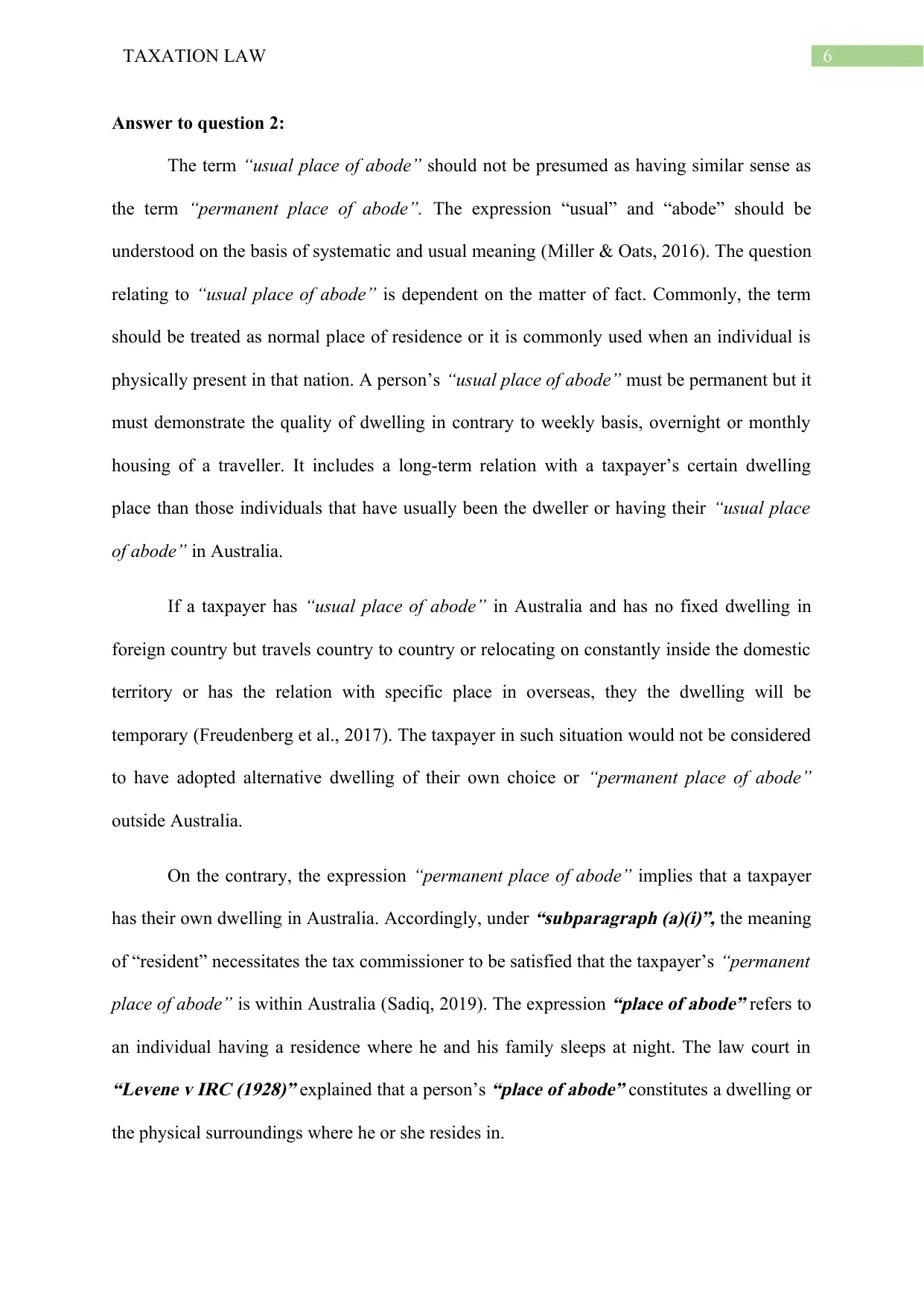
6TAXATION LAW
Answer to question 2:
The term “usual place of abode” should not be presumed as having similar sense as
the term “permanent place of abode”. The expression “usual” and “abode” should be
understood on the basis of systematic and usual meaning (Miller & Oats, 2016). The question
relating to “usual place of abode” is dependent on the matter of fact. Commonly, the term
should be treated as normal place of residence or it is commonly used when an individual is
physically present in that nation. A person’s “usual place of abode” must be permanent but it
must demonstrate the quality of dwelling in contrary to weekly basis, overnight or monthly
housing of a traveller. It includes a long-term relation with a taxpayer’s certain dwelling
place than those individuals that have usually been the dweller or having their “usual place
of abode” in Australia.
If a taxpayer has “usual place of abode” in Australia and has no fixed dwelling in
foreign country but travels country to country or relocating on constantly inside the domestic
territory or has the relation with specific place in overseas, they the dwelling will be
temporary (Freudenberg et al., 2017). The taxpayer in such situation would not be considered
to have adopted alternative dwelling of their own choice or “permanent place of abode”
outside Australia.
On the contrary, the expression “permanent place of abode” implies that a taxpayer
has their own dwelling in Australia. Accordingly, under
“subparagraph (a)(i)”, the meaning
of “resident” necessitates the tax commissioner to be satisfied that the taxpayer’s “permanent
place of abode” is within Australia (Sadiq, 2019). The expression
“place of abode” refers to
an individual having a residence where he and his family sleeps at night. The law court in
“Levene v IRC (1928)” explained that a person’s
“place of abode” constitutes a dwelling or
the physical surroundings where he or she resides in.
Answer to question 2:
The term “usual place of abode” should not be presumed as having similar sense as
the term “permanent place of abode”. The expression “usual” and “abode” should be
understood on the basis of systematic and usual meaning (Miller & Oats, 2016). The question
relating to “usual place of abode” is dependent on the matter of fact. Commonly, the term
should be treated as normal place of residence or it is commonly used when an individual is
physically present in that nation. A person’s “usual place of abode” must be permanent but it
must demonstrate the quality of dwelling in contrary to weekly basis, overnight or monthly
housing of a traveller. It includes a long-term relation with a taxpayer’s certain dwelling
place than those individuals that have usually been the dweller or having their “usual place
of abode” in Australia.
If a taxpayer has “usual place of abode” in Australia and has no fixed dwelling in
foreign country but travels country to country or relocating on constantly inside the domestic
territory or has the relation with specific place in overseas, they the dwelling will be
temporary (Freudenberg et al., 2017). The taxpayer in such situation would not be considered
to have adopted alternative dwelling of their own choice or “permanent place of abode”
outside Australia.
On the contrary, the expression “permanent place of abode” implies that a taxpayer
has their own dwelling in Australia. Accordingly, under
“subparagraph (a)(i)”, the meaning
of “resident” necessitates the tax commissioner to be satisfied that the taxpayer’s “permanent
place of abode” is within Australia (Sadiq, 2019). The expression
“place of abode” refers to
an individual having a residence where he and his family sleeps at night. The law court in
“Levene v IRC (1928)” explained that a person’s
“place of abode” constitutes a dwelling or
the physical surroundings where he or she resides in.
Paraphrase This Document
Need a fresh take? Get an instant paraphrase of this document with our AI Paraphraser
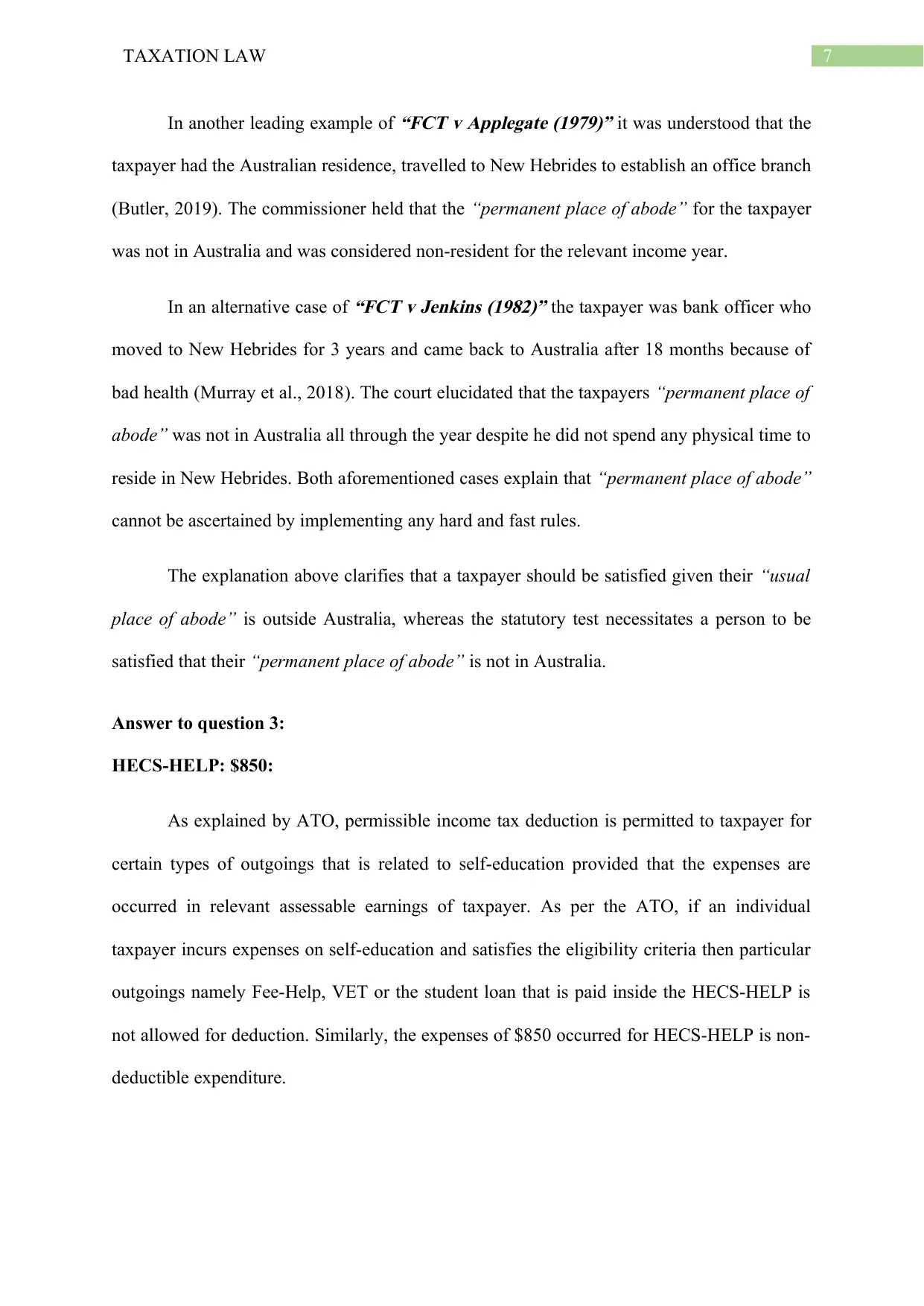
7TAXATION LAW
In another leading example of
“FCT v Applegate (1979)” it was understood that the
taxpayer had the Australian residence, travelled to New Hebrides to establish an office branch
(Butler, 2019). The commissioner held that the “permanent place of abode” for the taxpayer
was not in Australia and was considered non-resident for the relevant income year.
In an alternative case of
“FCT v Jenkins (1982)” the taxpayer was bank officer who
moved to New Hebrides for 3 years and came back to Australia after 18 months because of
bad health (Murray et al., 2018). The court elucidated that the taxpayers “permanent place of
abode” was not in Australia all through the year despite he did not spend any physical time to
reside in New Hebrides. Both aforementioned cases explain that “permanent place of abode”
cannot be ascertained by implementing any hard and fast rules.
The explanation above clarifies that a taxpayer should be satisfied given their “usual
place of abode” is outside Australia, whereas the statutory test necessitates a person to be
satisfied that their “permanent place of abode” is not in Australia.
Answer to question 3:
HECS-HELP: $850:
As explained by ATO, permissible income tax deduction is permitted to taxpayer for
certain types of outgoings that is related to self-education provided that the expenses are
occurred in relevant assessable earnings of taxpayer. As per the ATO, if an individual
taxpayer incurs expenses on self-education and satisfies the eligibility criteria then particular
outgoings namely Fee-Help, VET or the student loan that is paid inside the HECS-HELP is
not allowed for deduction. Similarly, the expenses of $850 occurred for HECS-HELP is non-
deductible expenditure.
In another leading example of
“FCT v Applegate (1979)” it was understood that the
taxpayer had the Australian residence, travelled to New Hebrides to establish an office branch
(Butler, 2019). The commissioner held that the “permanent place of abode” for the taxpayer
was not in Australia and was considered non-resident for the relevant income year.
In an alternative case of
“FCT v Jenkins (1982)” the taxpayer was bank officer who
moved to New Hebrides for 3 years and came back to Australia after 18 months because of
bad health (Murray et al., 2018). The court elucidated that the taxpayers “permanent place of
abode” was not in Australia all through the year despite he did not spend any physical time to
reside in New Hebrides. Both aforementioned cases explain that “permanent place of abode”
cannot be ascertained by implementing any hard and fast rules.
The explanation above clarifies that a taxpayer should be satisfied given their “usual
place of abode” is outside Australia, whereas the statutory test necessitates a person to be
satisfied that their “permanent place of abode” is not in Australia.
Answer to question 3:
HECS-HELP: $850:
As explained by ATO, permissible income tax deduction is permitted to taxpayer for
certain types of outgoings that is related to self-education provided that the expenses are
occurred in relevant assessable earnings of taxpayer. As per the ATO, if an individual
taxpayer incurs expenses on self-education and satisfies the eligibility criteria then particular
outgoings namely Fee-Help, VET or the student loan that is paid inside the HECS-HELP is
not allowed for deduction. Similarly, the expenses of $850 occurred for HECS-HELP is non-
deductible expenditure.
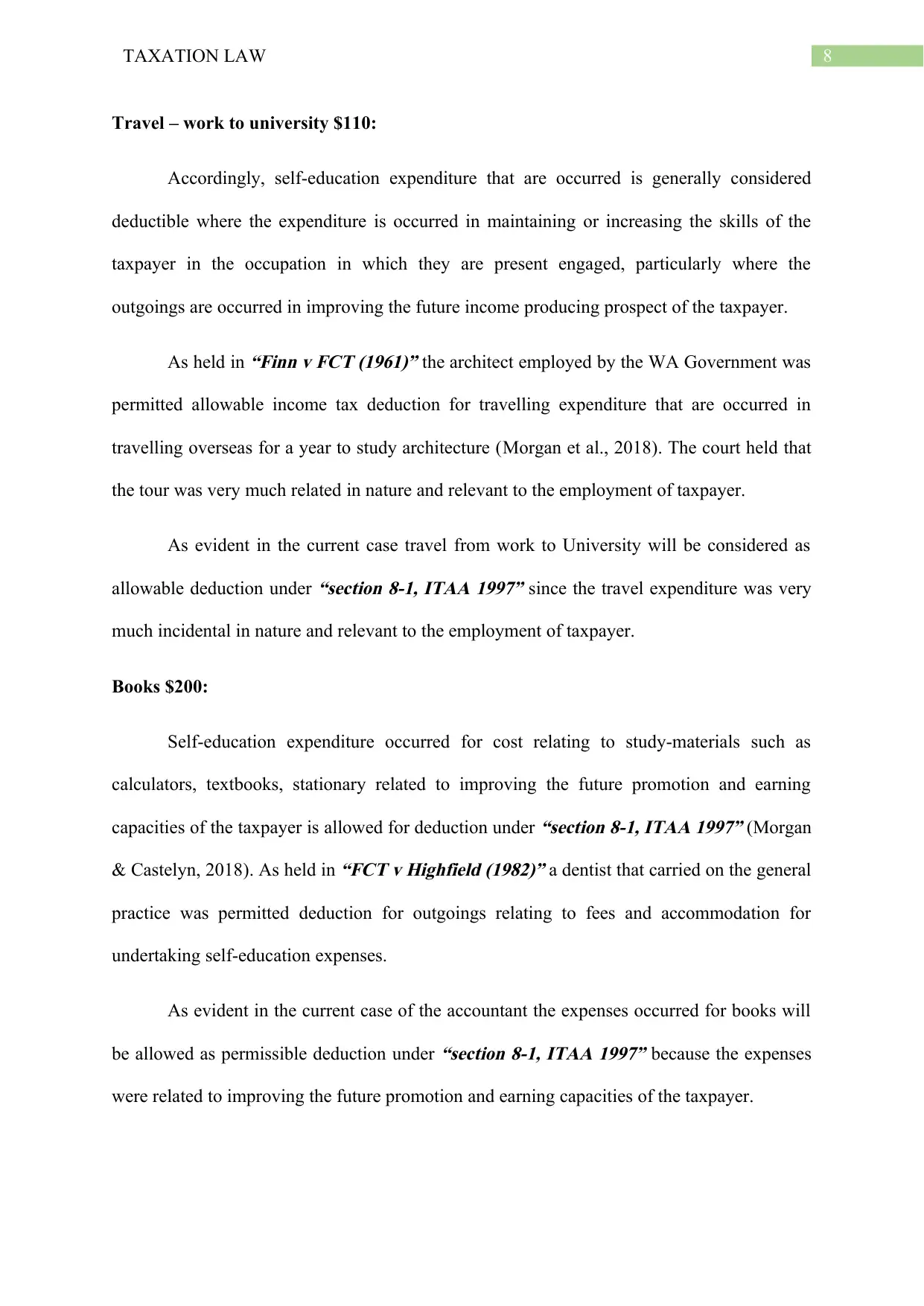
8TAXATION LAW
Travel – work to university $110:
Accordingly, self-education expenditure that are occurred is generally considered
deductible where the expenditure is occurred in maintaining or increasing the skills of the
taxpayer in the occupation in which they are present engaged, particularly where the
outgoings are occurred in improving the future income producing prospect of the taxpayer.
As held in
“Finn v FCT (1961)” the architect employed by the WA Government was
permitted allowable income tax deduction for travelling expenditure that are occurred in
travelling overseas for a year to study architecture (Morgan et al., 2018). The court held that
the tour was very much related in nature and relevant to the employment of taxpayer.
As evident in the current case travel from work to University will be considered as
allowable deduction under
“section 8-1, ITAA 1997” since the travel expenditure was very
much incidental in nature and relevant to the employment of taxpayer.
Books $200:
Self-education expenditure occurred for cost relating to study-materials such as
calculators, textbooks, stationary related to improving the future promotion and earning
capacities of the taxpayer is allowed for deduction under
“section 8-1, ITAA 1997” (Morgan
& Castelyn, 2018). As held in
“FCT v Highfield (1982)” a dentist that carried on the general
practice was permitted deduction for outgoings relating to fees and accommodation for
undertaking self-education expenses.
As evident in the current case of the accountant the expenses occurred for books will
be allowed as permissible deduction under
“section 8-1, ITAA 1997” because the expenses
were related to improving the future promotion and earning capacities of the taxpayer.
Travel – work to university $110:
Accordingly, self-education expenditure that are occurred is generally considered
deductible where the expenditure is occurred in maintaining or increasing the skills of the
taxpayer in the occupation in which they are present engaged, particularly where the
outgoings are occurred in improving the future income producing prospect of the taxpayer.
As held in
“Finn v FCT (1961)” the architect employed by the WA Government was
permitted allowable income tax deduction for travelling expenditure that are occurred in
travelling overseas for a year to study architecture (Morgan et al., 2018). The court held that
the tour was very much related in nature and relevant to the employment of taxpayer.
As evident in the current case travel from work to University will be considered as
allowable deduction under
“section 8-1, ITAA 1997” since the travel expenditure was very
much incidental in nature and relevant to the employment of taxpayer.
Books $200:
Self-education expenditure occurred for cost relating to study-materials such as
calculators, textbooks, stationary related to improving the future promotion and earning
capacities of the taxpayer is allowed for deduction under
“section 8-1, ITAA 1997” (Morgan
& Castelyn, 2018). As held in
“FCT v Highfield (1982)” a dentist that carried on the general
practice was permitted deduction for outgoings relating to fees and accommodation for
undertaking self-education expenses.
As evident in the current case of the accountant the expenses occurred for books will
be allowed as permissible deduction under
“section 8-1, ITAA 1997” because the expenses
were related to improving the future promotion and earning capacities of the taxpayer.
⊘ This is a preview!⊘
Do you want full access?
Subscribe today to unlock all pages.

Trusted by 1+ million students worldwide
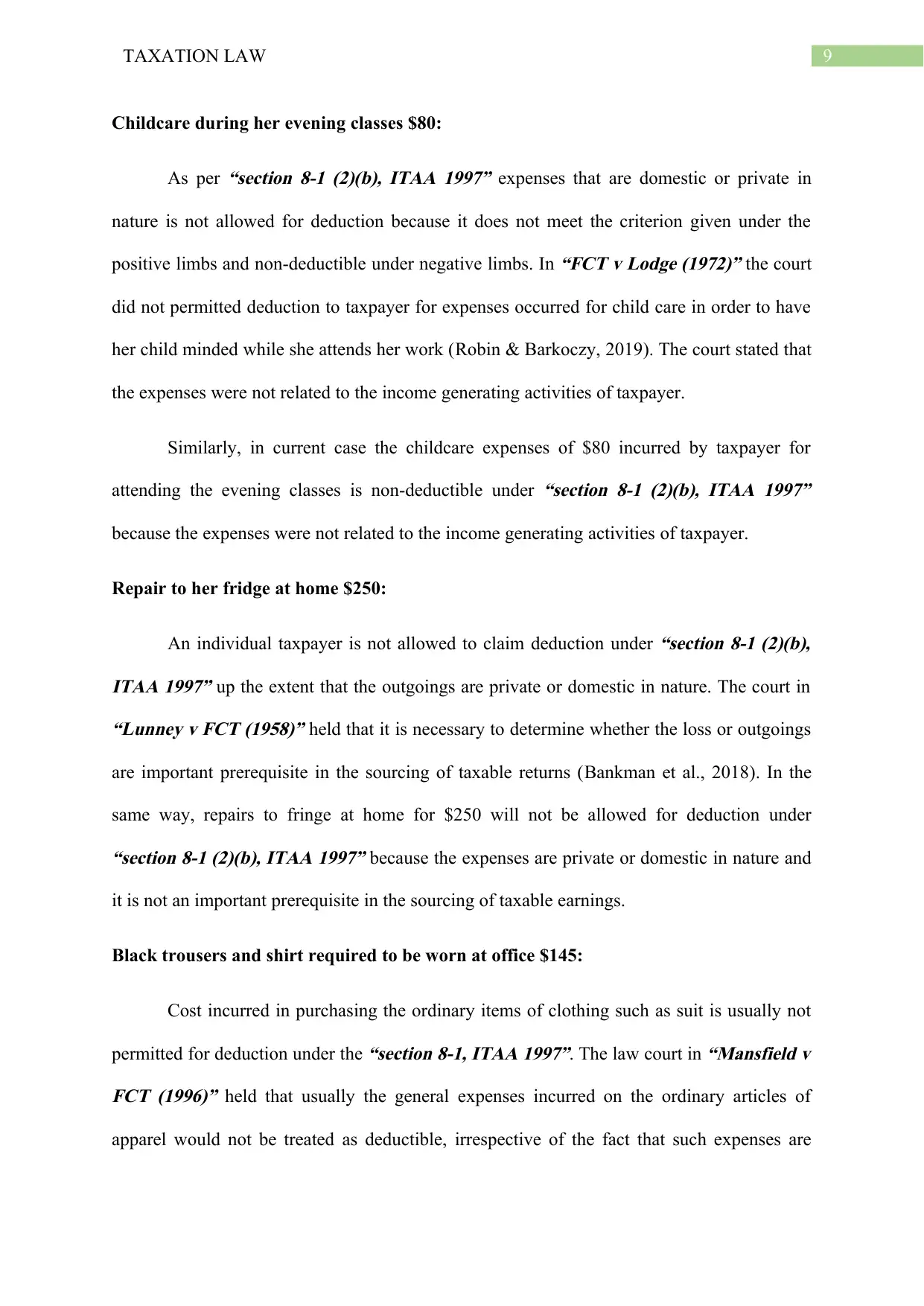
9TAXATION LAW
Childcare during her evening classes $80:
As per
“section 8-1 (2)(b), ITAA 1997” expenses that are domestic or private in
nature is not allowed for deduction because it does not meet the criterion given under the
positive limbs and non-deductible under negative limbs. In
“FCT v Lodge (1972)” the court
did not permitted deduction to taxpayer for expenses occurred for child care in order to have
her child minded while she attends her work (Robin & Barkoczy, 2019). The court stated that
the expenses were not related to the income generating activities of taxpayer.
Similarly, in current case the childcare expenses of $80 incurred by taxpayer for
attending the evening classes is non-deductible under
“section 8-1 (2)(b), ITAA 1997”
because the expenses were not related to the income generating activities of taxpayer.
Repair to her fridge at home $250:
An individual taxpayer is not allowed to claim deduction under
“section 8-1 (2)(b),
ITAA 1997” up the extent that the outgoings are private or domestic in nature. The court in
“Lunney v FCT (1958)” held that it is necessary to determine whether the loss or outgoings
are important prerequisite in the sourcing of taxable returns (Bankman et al., 2018). In the
same way, repairs to fringe at home for $250 will not be allowed for deduction under
“section 8-1 (2)(b), ITAA 1997” because the expenses are private or domestic in nature and
it is not an important prerequisite in the sourcing of taxable earnings.
Black trousers and shirt required to be worn at office $145:
Cost incurred in purchasing the ordinary items of clothing such as suit is usually not
permitted for deduction under the
“section 8-1, ITAA 1997”. The law court in
“Mansfield v
FCT (1996)” held that usually the general expenses incurred on the ordinary articles of
apparel would not be treated as deductible, irrespective of the fact that such expenses are
Childcare during her evening classes $80:
As per
“section 8-1 (2)(b), ITAA 1997” expenses that are domestic or private in
nature is not allowed for deduction because it does not meet the criterion given under the
positive limbs and non-deductible under negative limbs. In
“FCT v Lodge (1972)” the court
did not permitted deduction to taxpayer for expenses occurred for child care in order to have
her child minded while she attends her work (Robin & Barkoczy, 2019). The court stated that
the expenses were not related to the income generating activities of taxpayer.
Similarly, in current case the childcare expenses of $80 incurred by taxpayer for
attending the evening classes is non-deductible under
“section 8-1 (2)(b), ITAA 1997”
because the expenses were not related to the income generating activities of taxpayer.
Repair to her fridge at home $250:
An individual taxpayer is not allowed to claim deduction under
“section 8-1 (2)(b),
ITAA 1997” up the extent that the outgoings are private or domestic in nature. The court in
“Lunney v FCT (1958)” held that it is necessary to determine whether the loss or outgoings
are important prerequisite in the sourcing of taxable returns (Bankman et al., 2018). In the
same way, repairs to fringe at home for $250 will not be allowed for deduction under
“section 8-1 (2)(b), ITAA 1997” because the expenses are private or domestic in nature and
it is not an important prerequisite in the sourcing of taxable earnings.
Black trousers and shirt required to be worn at office $145:
Cost incurred in purchasing the ordinary items of clothing such as suit is usually not
permitted for deduction under the
“section 8-1, ITAA 1997”. The law court in
“Mansfield v
FCT (1996)” held that usually the general expenses incurred on the ordinary articles of
apparel would not be treated as deductible, irrespective of the fact that such expenses are
Paraphrase This Document
Need a fresh take? Get an instant paraphrase of this document with our AI Paraphraser
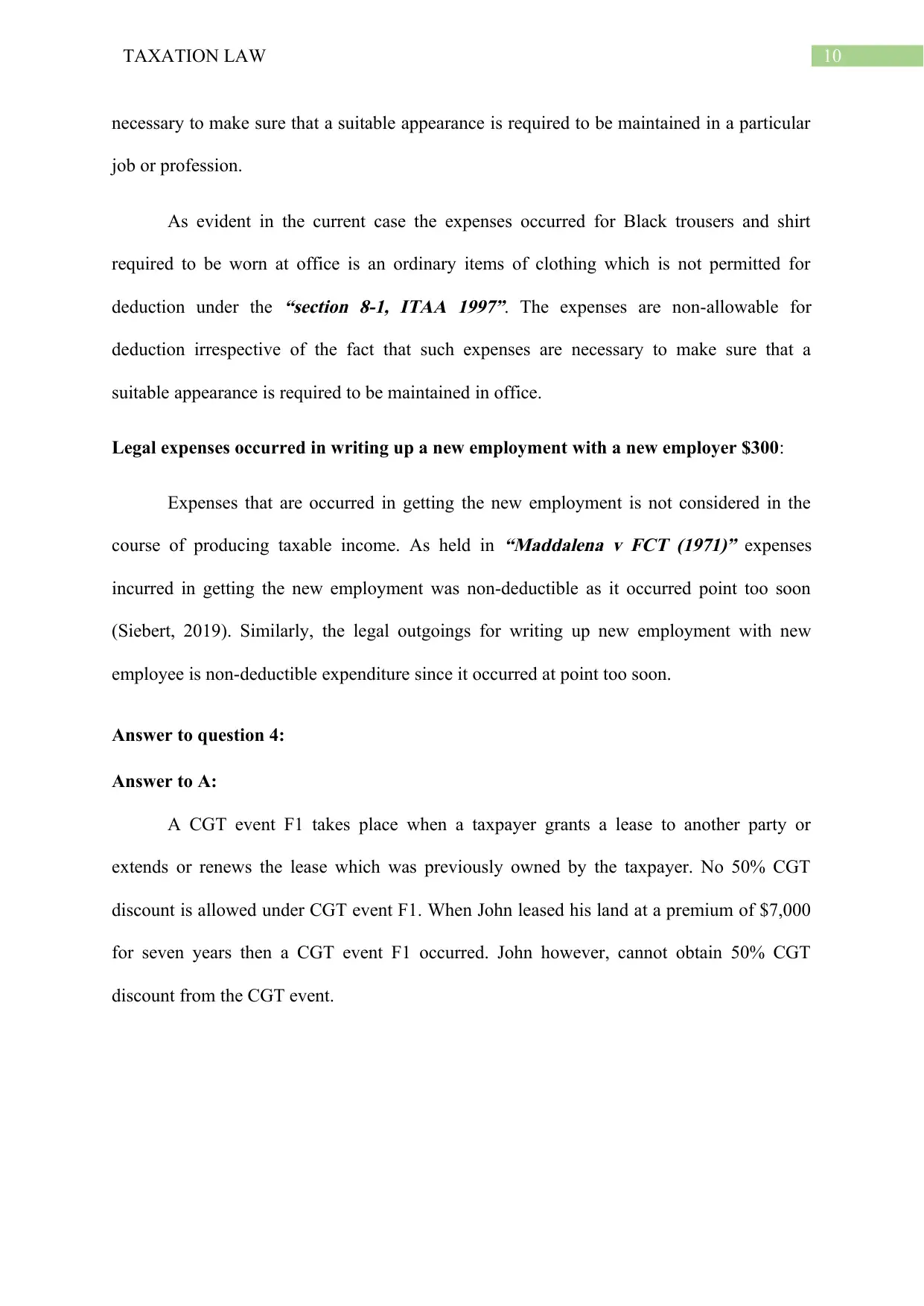
10TAXATION LAW
necessary to make sure that a suitable appearance is required to be maintained in a particular
job or profession.
As evident in the current case the expenses occurred for Black trousers and shirt
required to be worn at office is an ordinary items of clothing which is not permitted for
deduction under the
“section 8-1, ITAA 1997”. The expenses are non-allowable for
deduction irrespective of the fact that such expenses are necessary to make sure that a
suitable appearance is required to be maintained in office.
Legal expenses occurred in writing up a new employment with a new employer $300:
Expenses that are occurred in getting the new employment is not considered in the
course of producing taxable income. As held in
“Maddalena v FCT (1971)” expenses
incurred in getting the new employment was non-deductible as it occurred point too soon
(Siebert, 2019). Similarly, the legal outgoings for writing up new employment with new
employee is non-deductible expenditure since it occurred at point too soon.
Answer to question 4:
Answer to A:
A CGT event F1 takes place when a taxpayer grants a lease to another party or
extends or renews the lease which was previously owned by the taxpayer. No 50% CGT
discount is allowed under CGT event F1. When John leased his land at a premium of $7,000
for seven years then a CGT event F1 occurred. John however, cannot obtain 50% CGT
discount from the CGT event.
necessary to make sure that a suitable appearance is required to be maintained in a particular
job or profession.
As evident in the current case the expenses occurred for Black trousers and shirt
required to be worn at office is an ordinary items of clothing which is not permitted for
deduction under the
“section 8-1, ITAA 1997”. The expenses are non-allowable for
deduction irrespective of the fact that such expenses are necessary to make sure that a
suitable appearance is required to be maintained in office.
Legal expenses occurred in writing up a new employment with a new employer $300:
Expenses that are occurred in getting the new employment is not considered in the
course of producing taxable income. As held in
“Maddalena v FCT (1971)” expenses
incurred in getting the new employment was non-deductible as it occurred point too soon
(Siebert, 2019). Similarly, the legal outgoings for writing up new employment with new
employee is non-deductible expenditure since it occurred at point too soon.
Answer to question 4:
Answer to A:
A CGT event F1 takes place when a taxpayer grants a lease to another party or
extends or renews the lease which was previously owned by the taxpayer. No 50% CGT
discount is allowed under CGT event F1. When John leased his land at a premium of $7,000
for seven years then a CGT event F1 occurred. John however, cannot obtain 50% CGT
discount from the CGT event.
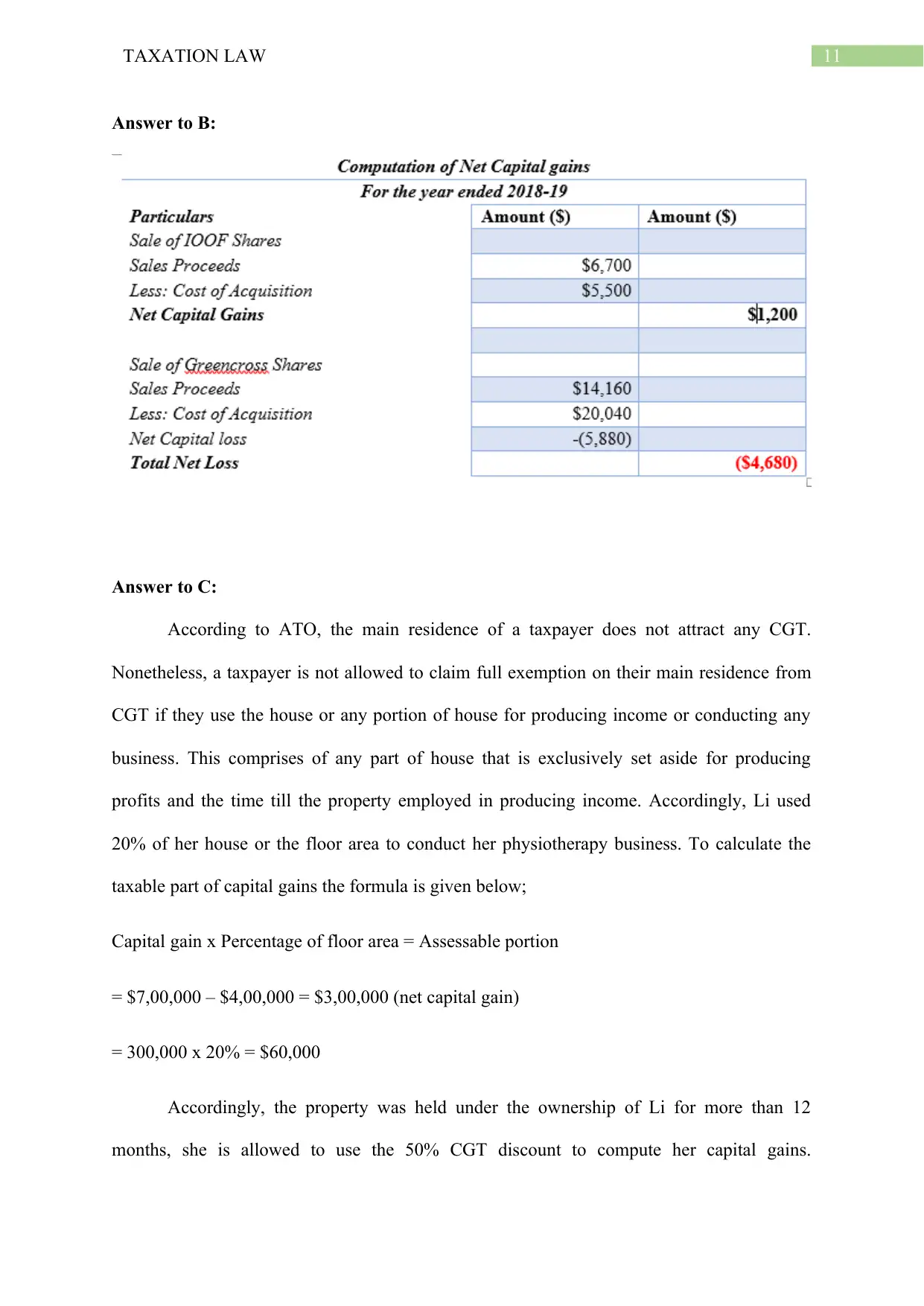
11TAXATION LAW
Answer to B:
Answer to C:
According to ATO, the main residence of a taxpayer does not attract any CGT.
Nonetheless, a taxpayer is not allowed to claim full exemption on their main residence from
CGT if they use the house or any portion of house for producing income or conducting any
business. This comprises of any part of house that is exclusively set aside for producing
profits and the time till the property employed in producing income. Accordingly, Li used
20% of her house or the floor area to conduct her physiotherapy business. To calculate the
taxable part of capital gains the formula is given below;
Capital gain x Percentage of floor area = Assessable portion
= $7,00,000 – $4,00,000 = $3,00,000 (net capital gain)
= 300,000 x 20% = $60,000
Accordingly, the property was held under the ownership of Li for more than 12
months, she is allowed to use the 50% CGT discount to compute her capital gains.
Answer to B:
Answer to C:
According to ATO, the main residence of a taxpayer does not attract any CGT.
Nonetheless, a taxpayer is not allowed to claim full exemption on their main residence from
CGT if they use the house or any portion of house for producing income or conducting any
business. This comprises of any part of house that is exclusively set aside for producing
profits and the time till the property employed in producing income. Accordingly, Li used
20% of her house or the floor area to conduct her physiotherapy business. To calculate the
taxable part of capital gains the formula is given below;
Capital gain x Percentage of floor area = Assessable portion
= $7,00,000 – $4,00,000 = $3,00,000 (net capital gain)
= 300,000 x 20% = $60,000
Accordingly, the property was held under the ownership of Li for more than 12
months, she is allowed to use the 50% CGT discount to compute her capital gains.
⊘ This is a preview!⊘
Do you want full access?
Subscribe today to unlock all pages.

Trusted by 1+ million students worldwide
1 out of 17
Related Documents
Your All-in-One AI-Powered Toolkit for Academic Success.
+13062052269
info@desklib.com
Available 24*7 on WhatsApp / Email
![[object Object]](/_next/static/media/star-bottom.7253800d.svg)
Unlock your academic potential
Copyright © 2020–2025 A2Z Services. All Rights Reserved. Developed and managed by ZUCOL.





